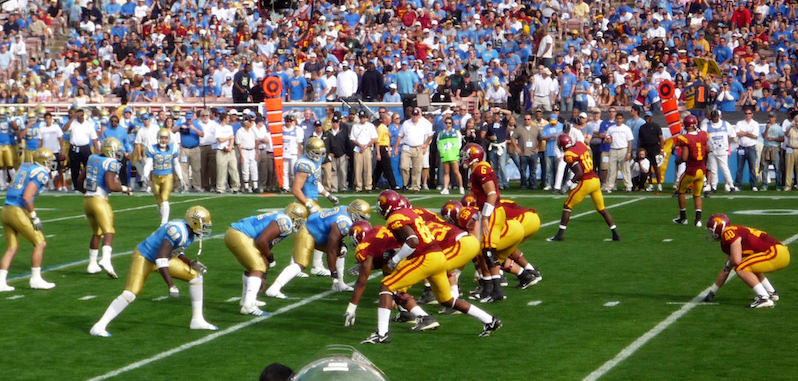Not All College Athletes Are Created (Economically) Equal—So They Shouldn’t All Be Paid
The controversial issue isn’t going away. But the focus should be on the big-revenue-producing sports, football and basketball.
The UCLA and USC football teams battle for Los Angeles bragging rights in their annual rivalry game. (Bobak Ha’Eri / CC BY-SA 3.0)
The question of whether or not college athletes should be paid isn’t going to go away, and for two simple reasons: College athletes continue to produce a huge amount of revenue, and they continue to do it even though they don’t get paid.
The latest crack at dealing with this issue comes from researcher Ryan McCready, who has a degree in economics and international business from the University of Arkansas. His paper on the subject—and it makes for interesting reading for anyone concerned with the issue—is called “Can Schools Actually Support Paying College Athletes? It’s Complicated.”
Can we pay student athletes? “In a lot of programs,” McCready writes, “like my alma mater, the University of Arkansas, and the other Power Five schools like it, that might be possible.” (The Power Five are the schools in the Southeastern Conference, Big 12, Big Ten, Pacific 12 and Atlantic Coast Conference.)
For those 60 or so schools, life is good for their athletic department. They see college football and sports in general as a great way to not only increase their visibility to the country but also make some serious cash. In fact, almost half a BILLION for the 12 SEC teams in 2015 and over $250 million for the 4 other Power Conferences.
But what about the other half of the college football landscape that isn’t rolling in the dough? This includes the other 60-ish teams who do not have the luxury of lucrative TV deals, billionaire donors or top recruits. These teams are known as the Group of Five conferences [the American Athletic Conference, Conference USA, Mid-American Conference, Mountain West Conference and Sun Belt Conference] and are like little brothers to the Power Five teams. They line up every Saturday in the fall and often go to battle against teams that have 10 times their budget. And they are the ones who would struggle to pay their players, as we will quickly see.
Oh, and that is only for the 125 or so Division I schools. We don’t even get into the other levels mostly because I don’t think it would be possible for a majority of those to even think about paying players. … If you think college sports is a cash cow for all schools, you’re in for a rude awakening.
I urge everyone to read McCready’s entire essay. Using data from a USA Today report that ranked 231 athletic departments by their profits, revenues and expenses over a 10-year period, he selected 100 public universities and “then compared that to their football performance. For each year, going back to 2005, we looked at the winning percentage, bowl outcome, coach and other pertinent data.”
To save you the time, I’ll go ahead and tell you that McCready crunched the numbers, and Alabama’s Nick Saban is the coach with the most profitable athletic department. No surprise there, as Alabama has won four national championships since he signed with the Crimson Tide in 2007.
I don’t want to be a spoiler, and I assume that all readers will follow my recommendation and read McCready’s entire well-researched essay, but in the interest of moving on I’ll go to his conclusions: “Sorry to spoil the suspense, but it is not feasible to pay every college athlete, whether it be football, basketball, or even tennis. The profit margins for every team would have to be much bigger for that to be possible at this time. What I do think is very possible is an increase in the scholarships that all athletes receive. Which some schools are already doing.”
I respect McCready’s research and his concern for fairness to the schools and their athletes, but I disagree, entirely, with his conclusions. First off, I disagree with his premise—which others who have looked into this topic, including Sports Illustrated a couple of years ago, share—that every college athlete should be paid. I don’t think tennis players, golfers, track and field athletes, or even hockey or baseball players (though I haven’t researched this carefully) need to be paid.
To put it another way, I don’t see why athletes who play sports that don’t pull in substantial revenues should expect a paycheck. I think the discussion should be confined to the big-revenue-producing sports: football and basketball. In fact, I think it should be the way I always heard from college administrators that it should be: The revenue from football and basketball should pay for the other sports.
But no matter how much revenue football and basketball produce, there will never be enough to pay the players, at least if the issue is left up to athletic departments. In the 1960s, when teams were allowed one televised home game a year and one road game appearance on TV, there wasn’t enough money to pay the players. Now, with huge cash flows coming from massive TV contracts and live streaming games on the internet, plus a huge increase in merchandising revenue, they still don’t have enough money to play the players.
Where does the money go? Well, I’m sure a substantial amount is kicked in for new libraries and science labs, but, essentially, the increased income has gone to bigger coaching staffs and state-of-the-art training facilities. And if new revenue streams are found, you can bet that’s where the dollars will continue to go.
It may be true—and I believe it is true—that most football programs lose money. Murray Sperber, a pioneer in the study of college sports, told me 20 years ago that he believed 80 percent to 85 percent of college programs were in the red. So then, if most programs lose money on football, how can they afford to pay football players?
That seems like a sensible question until you remember that most colleges lose money on football but still have their football programs. If you can afford to pay a head coach more money than the college president (which is the case with most big schools) and afford 12-to-15-person coaching staffs and afford to maintain training facilities and a stadium, why can’t you afford to pay for the people whose sweat and blood make these things possible in the first place?
“If I was a coach,” says McCready, “I would gladly take a pay cut to help my players. Especially with so many news stories of players stealing to get by or taking money from less than reputable people.” And “if the individual schools cannot afford to increase the scholarships of its athletes, the NCAA could step in. I mean, they did make almost a billion dollars in 2015 with almost $100 million in profits.”
I don’t think so. No coach is going to gladly take a pay cut. As to the NCAA stepping in to help with scholarships, that’s not going to happen either. The NCAA didn’t “make” almost a billion dollars last year. It took that revenue from its member colleges, and the colleges got it from the efforts of the student-athletes who played football and basketball essentially for free.
What I don’t think McCready or most members of the sports media really understand is that the NCAA exists for one reason only: to control the earning power of college athletes. This is why they can’t sign autographs for money, sell memorabilia or even take outside jobs without NCAA approval. Because of the NCAA, college athletes don’t even have the same rights under the law as other college students.
Of course, colleges can afford to pay their athletes, or at least their football and basketball players. If they couldn’t, there wouldn’t be college football or basketball at all.
The only way this ridiculous inequity will be redressed is when college athletes are organized enough to demand their rights. When they do, we’ll find out exactly how much the universities can afford to pay them.
The coaches and staffs of the athletic departments can be paid with the money that’s left over.
Independent journalism is under threat and overshadowed by heavily funded mainstream media.
You can help level the playing field. Become a member.
Your tax-deductible contribution keeps us digging beneath the headlines to give you thought-provoking, investigative reporting and analysis that unearths what's really happening- without compromise.
Give today to support our courageous, independent journalists.





You need to be a supporter to comment.
There are currently no responses to this article.
Be the first to respond.